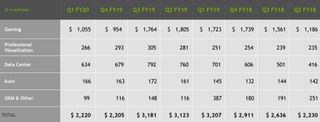Nvidia talks ray tracing, PC versus console gaming, and $1 billion drop in revenue
PCs are where the action is at, Nvidia says.

Nvidia had some interesting things to say after posting financial results for the first quarter of its fiscal 2020 (which ended April 28, 2019 for the company). During a subsequent earnings call with investors, Nvidia talked about the current and future states of ray tracing, how it feels about the PC platform, and a bunch of other stuff.
We'll get to all of that, but first let's have a look at the numbers. At a cursory glance, they're not so rosy—Nvidia raked in $2.22 billion during the quarter, compared to $3.21 billion in the same quarter a year earlier. So in essence, Nvidia saw its revenue plummet by around nearly $1 billion over the past year.
I won't pretend to be a Wall Street analyst, but it seems clear that Nvidia finds itself in a post-crypto hangover, as Dr. Jon Peddie, founder and president of market research firm Jon Peddie Research (and who is an analyst), dubbed it in March.
"The channel’s demand for add-in boards (AIBs) in early 2018 was out of sync with what was happening in the market," Dr. Peddie said at the time. "As a result, the channel was burdened with too much inventory. That has impacted sales of discrete GPUs in Q4, and will likely be evident in Q1, and Q2’19 as well."
It appears his crystal ball was functioning properly when he made that prediction. However, while Nvidia's GPU sales were clearly bolstered by the cryptocurrency market last year, it now finds itself "back on an upward trajectory." This can be seen in its gaming revenue, which is down more than $680 million year-over-year, but up $101 million from the previous quarter.

"We’ve returned to growth in gaming, with nearly 100 new GeForce Max-Q laptops shipping. And Nvidia RTX has gained broad industry support, making ray tracing the standard for next-generation gaming," said Jensen Huang, founder and CEO of Nvidia.
The numbers are actually better than what analysts were expecting, according to multiple reports. In addition, Nvidia is singing a different tune about its efforts to promote ray tracing. Back in January, Huang called the fourth quarter "a real punch in the gut," adding that "some customers may have delayed their purchase [of Turing cards] while waiting for lower price points and further demonstrations of RTX technology in actual games."
The biggest gaming news, reviews and hardware deals
Keep up to date with the most important stories and the best deals, as picked by the PC Gamer team.
Fast forward to now and Nvidia's message is that ray tracing has arrived in force.
"Our strategy with RTX was to take a lead and move the world to ray tracing. And at this point I think it's fairly safe to say that that the leadership position that we've taken has turned into a movement that has turned next generation gaming ray tracing into a standard," Huang said. "Almost every single game platform will have to have ray tracing and some of them already announced it and the partnerships that we've developed are fantastic."
"Microsoft DXR is supporting ray tracing, Unity supports ray tracing, Epic is supporting ray tracing, leading publishers like EA have adopted RTX and support ray tracing, and movie studios, Pixar has adopted—announced that they're using RTX and will use artifacts to accelerate their rendering of films," Huang added.
Nvidia is definitely looking at the landscape through RTX-colored glasses, though it's true that ray tracing support is increasing. It's just not everywhere yet. There's a reason why Nvidia expanded its Turing lineup with GTX graphics cards (GeForce GTX 1660 Ti, 1660, and 1650) that lack dedicated RT cores, and it's not because ray tracing is in every game.
Still, Nvidia is bullish on ray tracing in general, in games and elsewhere.
"Adobe and Autodesk jumped on to RTX and that will bring ray tracing to their content and their tools. And so, I think at this point it's fair to say that that ray tracing is the next generation and it's going to be adopted all over the world," Huang said.
He also pointed to the popularity of gaming on PC. Huang said we are in the midst of a "great PC cycle because it is the end of the console cycle," meaning that the Xbox One and PlayStation 4 have gone about as far as they can go. There is a PlayStation 5 off in the distance that will use AMD's next-gen CPU (Zen 2) and GPU (Navi) hardware, and Microsoft is cooking up a new console as well. But at this moment in time, Huang is saying PCs have a definite advantage over consoles.
"PCs are where the action's at these days. With battle royale and esports and so much social going on, the PC gaming ecosystem is just really vibrant," Huang said.
It's worth noting that Nvidia also has a vested interest in console gaming, as it pertains to the Nintendo Switch. By and large, however, Nvidia is mostly concentrated on the PC platform. It also sees continued opportunity in the cloud.
"Our strategy for cloud gaming is to extend our PC position for GeForce gamers into the cloud. And our strategy for our building out our network is partnerships with telcos around the world. And so, we'll build out some of it. And on top of the service, we have our entire PC gaming stack and when we host the service, we will move toward a subscription model," Huang said.
All that said, the next couple of quarters will provide a better picture of where Nvidia stands. AMD is getting ready to announce new products based on its Navi GPU architecture, which will be shipping in the third quarter. We don't anticipate the first generation of Navi competing with Nvidia's fastest offerings, and ray tracing support might be missing as well. But if AMD can compete with cards like the GeForce RTX 2070 and 2080 while undercutting Nvidia on price, it could change the outlook. We'll just have to wait and see.
Paul has been playing PC games and raking his knuckles on computer hardware since the Commodore 64. He does not have any tattoos, but thinks it would be cool to get one that reads LOAD"*",8,1. In his off time, he rides motorcycles and wrestles alligators (only one of those is true).
Most Popular






